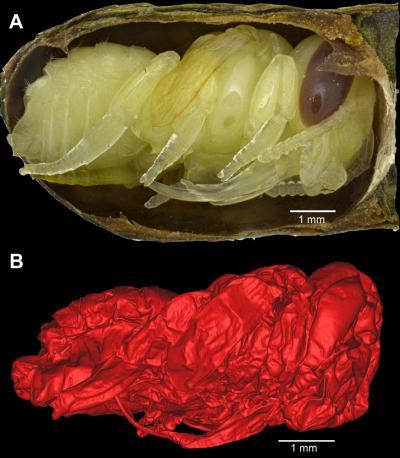The La Brea Tar Pits in California are known for saber-toothed cats and mastodons but they also have insects. Recent examination of fossil leafcutter bee nest cells, led by Anna Holden of Natural History Museum of Los Angeles County and colleagues, reveal insights into the habitat and climate at the La Brea Tar Pits toward the last Ice Age.
Holden conducted the study with bee specialists Jon B. Koch and Dr. Terry Griswold from Utah State University, paleobotanist Dr. Diane M. Erwin, from the University of California Berkeley, and Justin Hall from NHM, who used micro CT scans to reconstruct images of the nest cells and bees.
It was necessary to micro CT scan the specimens in order for Holden and colleagues to determine that each leaf-constructed nest contained an intact pupae. The team examined the physical features of the bees, the nest cell architecture, and used environmental niche modeling to best match the ancient Ice Age specimens to Megachile gentilis.

This is a comparison of (A) a modern leafcutter bee pupa in a nest cell to (B) a micro CT scan reconstruction of a 23-40,000 year old leafcutter bee pupa. Images by Harold Ikerd, USDA-ARS Pollinating Insect Research Unit at Utah State University (modern pupa) and Justin Hall, Dinosaur Hall, Natural History Museum of Los Angeles County (CT scan reconstruction and figure).
Because M. gentilis still lives today (as is the case with most insects excavated from the tar pits), the team linked records of its restricted climatic range to late Ice Age environmental conditions at Rancho La Brea which suggest that M. gentilis lived in a moderately moist (mesic) environment that occurred at a lower elevation during the Late Pleistocene. The identification of nest cell leaf fragments, which were collected in close proximity to the nest site, indicate a nearby wooded or habitat with a stream or river.
These unusual bee fossils, housed at the Page Museum at the La Brea Tar Pits, were recovered from Pit 91. Dating back to the beginning of the 20th century, scientists have unearthed more than 5 million fossils representing 600+ species of plants and animals from the tar pits — evidence that Los Angeles was densely populated by wildlife for more than 50,000 years. "This vast treasure trove of fossils is key to understanding the response of the wildlife and habitats of Southern California to global cooling and warming at the end of the Ice Age," said Dr. John Harris, Chief Curator of the Page Museum. "It affords an evolutionary perspective to ongoing climate change."
"Because this is a fossil of rare life-stage, it's an exceptional find in itself," Holden said. "But it's just the tip of the iceberg, we know that insects offer a vivid portrait of the prehistoric conditions of this area, and there are literally thousands more to study."
Animation of fossil of male pupa and its position within the nest cell. Credit: Justin Hall, Dinosaur Hall, Natural History Museum of Los Angeles County




Comments